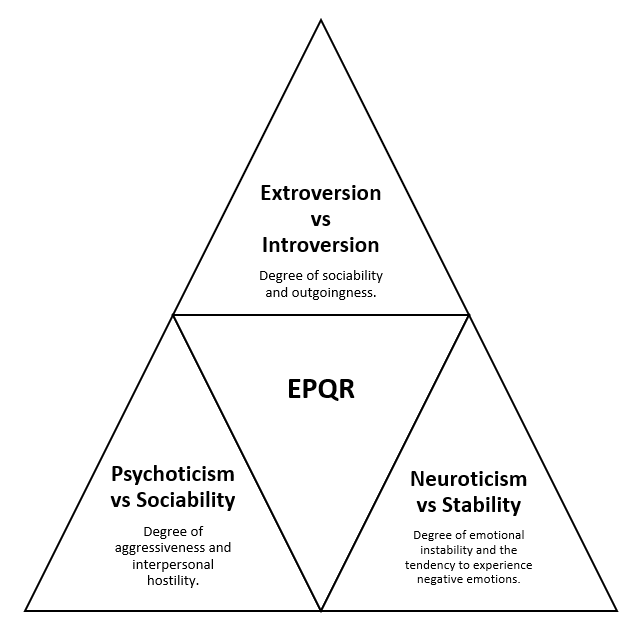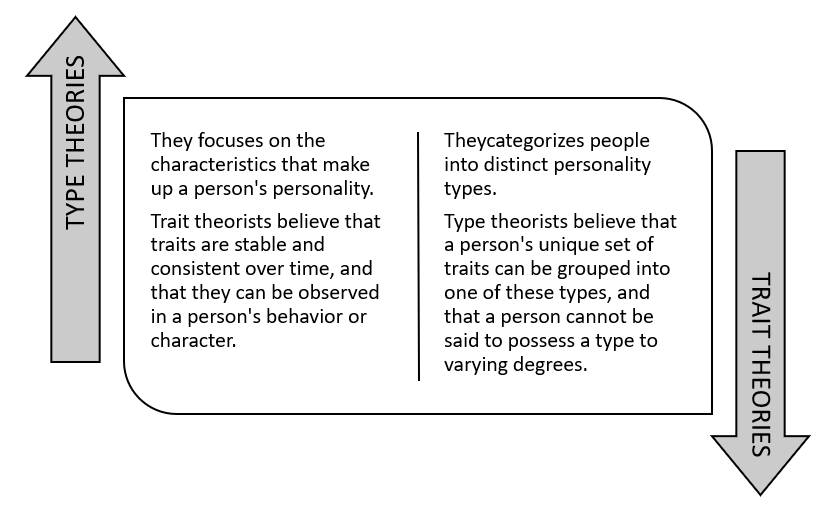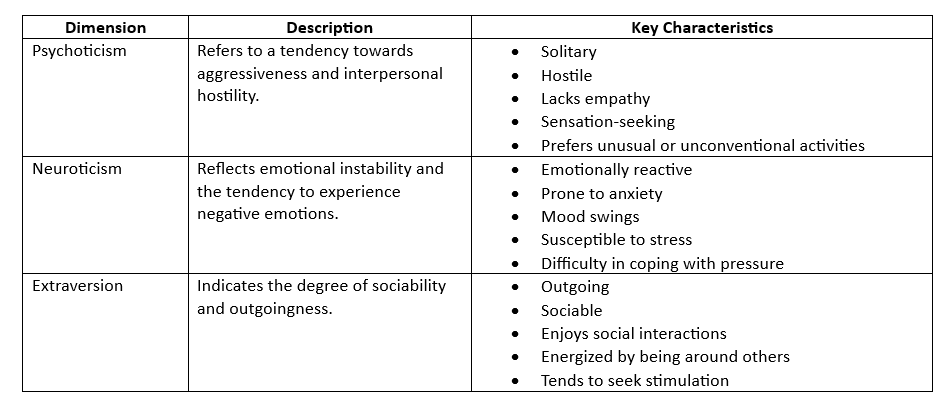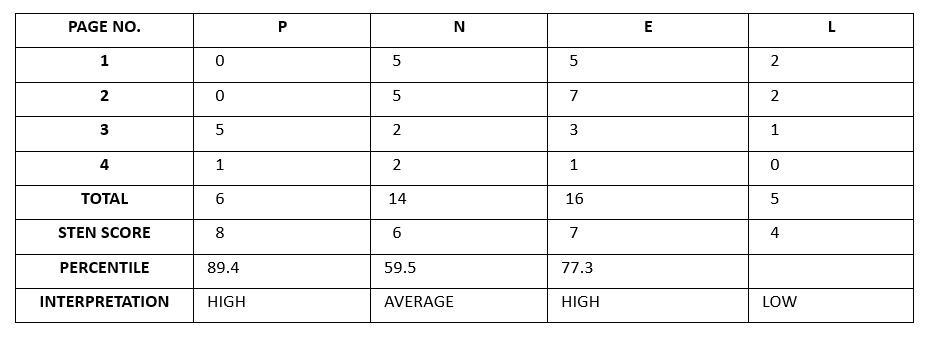EPQR
Eysenck’s Personality Questionnaire Revised (EPQR) was developed by Hans Jürgen Eysenck and Sybil B. G. Eysenck (1945), which is one of the most important personality test.
Although he was a behaviourist who considered learned habits of great importance, he believed that personality differences grow out of our genetic inheritance. He is, therefore, primarily interested in what is usually called temperament. (An aspect of our personalities i.e. genetically based, and present from birth or even before. In devising a temperament-based theory Eysenck did not exclude the possibility that some aspects of personality are learned, but left the consideration of these to other researchers.
Purpose of Eysenck’s Personality Questionnaire Revised (EPQR)
To measure the three personality dimensions- psychoticism, neuroticism and extraversion, of subject by using Eysenck’s Personality Questionnaire- Revised.
Introduction of Eysenck’s Personality Questionnaire Revised (EPQR)
Definition of Personality
The term ‘personality’ is derived from the Latin word ‘persona’, meaning mask. For psychologists, the term personality refers to such characteristics of the individual that distinguishes each individual from the other.
According to Witting and William-III (1984), “Personality is a set of characteristics- unique for each individual- that determines a person’s identity and behavioural pattern.”
According to Allport (1937), “Personality is the dynamic organization within the individual of those psychophysical systems that determine his unique adjustment to the environment.”
10 Important Definitions of Personality
- Gordon Allport (1937)- Personality is the dynamic organization within the individual of those psychophysical systems that determine his unique adjustments to his environment.
- Raymond Cattell (1965)- Personality is that which permits a prediction of what a person will do in a given situation.
- Carl Rogers (1959)- Personality is the organized, consistent pattern of perception of the ‘self,’ which influences behaviour.
- Sigmund Freud (1923)- Personality is made up of three components: the id, ego, and superego, which develop through early childhood experiences.
- F. Skinner (1953)- Personality is a collection of learned behaviours that arise through interaction with the environment.
- Hans Eysenck (1952)- Personality is a more or less stable and enduring organization of a person’s character, temperament, intellect, and physique, which determines his unique adjustment to the environment.
- Erik Erikson (1950)- Personality is formed through a series of psychosocial crises that individuals face at different stages of life.
- Walter Mischel (1968)- Personality is a product of the interaction between situational variables and personal dispositions.
- David Buss (1991)- Personality is a collection of evolved psychological mechanisms designed to solve problems of survival and reproduction.
- McCrae & Costa (1999)- Personality is a set of characteristic patterns of thoughts, feelings, and behaviours that distinguish individuals from one another.
Type Theories of Personality
- Hippocrates Classification– the Greek ancient physician Hippocrates also proposed a theological classification of personality based on fluid or humour (liquid chemicals). Histology includes-
- Sanguine is dominated by blood and are helpful.
- Phlegmatic is dominated by phlegm and are apathetic.
- Melancholic possess black bile and are characterized by gloominess.
- Choleric which is dominated by yellow bile and they acidic, irritable and excited.
- Morphology Classification– based on psychological attributions coupled with physique, some psychologists such as Sheldon, Kretschmer, Jung and Spragner have proposed classifications.
- Sheldon’s Classification- Sheldon (1940) divided human body into 3 types; ‘Endomorphs’ who tend to be fat, relaxed, insecure, and apprehensive; ‘Mesomorphs’ who tend to be muscular, assertive, and adventurous; and ‘Ectomorphs’ who tend to be thin, restrained, social and unamiable.
- Kretschmer’s Classification– he has classified into 3- ‘Pyknic’ who are short and flattened with bulged abdomen and are temperamentally happy, gay and mixing; ‘Asthenic’ who are lean, thin, eccentric, aloof, cool and calm; and ‘Athletic’ who have tightened muscles, widened shoulders, attractive, social, active, courageous etc.
- Jung has classified personality into introversion and extraversion. Spragner classified personality in terms of values- theoretical, economic, aesthetic, social, political and religious values.
Trait Theories of Personality
- Allport’s View- he proposed that ‘traits’ are the inherent attributes of mankind and is the ultimate reality of mankind’s personality. Allport holds that traits can be distinguished at three levels-
- cardinal traits which are highly generalized dispositions and have widespread impacts on behaviour, like Gandhi’s non-violence.
- Central traits are relatively less persuasive in effect but still quite generalized in disposition, like dominance, stability, etc.
- Secondary traits which appear in specific situations and hence are specific and narrow in effect.
- Cattell’s factor analysis of personality- Cattell believed that there is a common structure found in all personalities which should be empirically determined. He concluded that personality consists of 16 primary source traits which are the building blocks of personality. He further described the source traits in terms of opposing tendencies and developed a test of personality consisting 16 source traits (factors) which is popularly known as 16 Personality Factor Test (16 PF).
- Eysenck’s dimensions of personality- H.J. Eysenck proposed that personality can be reduced merely to two dimensions, which are biologically and genetically based, that subsume numerous specific traits. He developed three dimensions of personality-

Eysenck’s Personality Traits
- Neuroticism vs. Emotional stability which refers to the degree or extent an individual has control over feelings.
- Extroversion vs. Introversion which refers to the degree to which an individual is socially outgoing or socially withdrawn.
- Psychoticism vs Sociability which he presumes an interactive product of the other two dimensions.

Trait vs Type Theories
Similar Personality Tests
- NEO Five Factor Inventory 3- Developed by Paul T. Costa and Robert R. McCrae. The NEO FFI is a concise measure of the five major domains of personality, as well as the six traits or facets that define each domain. Read more.
- Minnesota Multiphasic Personality Inventory- the MMPI is most widely used and researched clinical assessment test used by mental health professionals to help diagnose mental health disorders. Originally developed in the late 1930’s, the test has been revised and updated several times to improve accuracy and validity. The MMPI-2 consists of 567 true-false questions and takes approximately 60-90 minutes to complete while MMPI-2-RF (reconstructed form) has 338 true-false questions taking 35-50 minutes to finish. The MMPI was developed in 1937 by S.R. Hathaway and J.C. McKinley. The test is also used in other fields such as legal cases, screening instruments for certain professions, although using it in this manner is highly controversial. The scales on MMPI-2 and MMPI-A include hypochondriasis, depression, hysteria, psychopathic deviate, masculinity-femininity, paranoia, schizophrenia, hypomania, introversion, etc.
Description of Eysenck’s Personality Questionnaire-Revised (EPQR)
The EPQR is the result of many years of development at work. It was devised by psychologists Hans Jürgen Eysenck and Sybil B. G. Eysenck. It was designed to give rough and ready measure of three important personality dimensions: psychoticism, extraversion and neuroticism. Each of these traits are means of 100 questions (yes/no type). Later it was revised and EPQ-R was introduced which consists of 90 questions (yes/no type) carefully selected after lengthy item analysis.
The earlier history of the development of inventories for the purpose of measuring these three traits have been reviewed in ‘The Structure of Human Personality’, and the detailed description of the actual derivation of the scale presented has also been published. The final version of EPQ is described in considerable detail in the book titled ‘Psychoticism: A Dimension of Personality’
Definition of the three scales and lie scale in EPQR
- Psychoticism- it is an independent dimension which describes the personality as solitary, troublesome, cruel, lacking in feeling and empathy, hostile to others, sensation seeking, and liking odd and unusual things.
- Neuroticism- It refers to the general emotional liability of a person, his emotional over-responsiveness and his liability to breakdown under stress.
- Extraversion- extraversion as opposed to introversion, refers to the out-going uninhibited, sociable proclivities of a person.
- Lie scale- personality questionnaires are subject to faking. Given that it is possible to dissimulate, it becomes important to attempt the construction of scales for the measurement of dissimulation. In order to prepare a lie scale for EPQR, several studies were carried out with a large number of items. These studies were attempted to establish the existence of the initiary factor of dissimulation and its independence of P, E and N.

Dimension of EPQR
Dicken had suggested possible and plausible reasons for high scoring on the lie scale:
- Deliberate faking with intent to deceive the user;
- Response in terms of an ideal self-concept rather than a candid self- appraisal;
- Response in terms of an ‘honest’ but inaccurate and un-insightful self-assessment;
- Genuine conformity to social rules and norms.
Test Description
- EPQR is a verbal paper pencil test in English.
- It can be administered either individually or in a group.
- Lie scale has been introduced to check whether people fake their answers. 4th dimension.
- Age group- 16 and above.
- There is No time limit.
Psychometric Properties of EPQR
Reliability of EPQR
Test-retest reliability for EPQ-R is very high. It ranges from 0.80-0.90.
Various groups were tested and retested with an interval of one month, a time interval enough for subject to have forgotten their original replies, but not long enough for any serious personality changes to have occurred. Results were favourable with reliabilities mostly lying between .80 to .90 region.
For males with a sample of 136 the test- retest reliability coefficient for neuroticism was found to be .89, for psychoticism it was .83, for that of extraversion it was .90 and for lie score it came out to be .86.
For females with a sample of 121 the test-retest reliability coefficient for neuroticism was found to be .80, for psychoticism it was .71, for that of extraversion it was .87 and for lie score it came out to be .86. With the total overall sample of 257, the test-retest reliability coefficient for neuroticism was found to be .86, for psychoticism it was .78, for that of extraversion it was .89 and for lie score it came out to be .84.
Consistency reliabilities- alpha coefficients are an indication of the degree to which the questions in the scale covers a given area. If these reliabilities are too low, the scale is too heterogeneous, if they are too high, it suggests the area covered is too restricted. For EPQR the coefficients observed are satisfactory, being neither too high nor too low; most are above .80 with only P scale reliability falling below this value (2 groups are tested- 1 normal population, 2- criminals in prison).
Validity of EPQR
Construct validity has been tested through factor analysis within and across various countries and cultures. (Barrett, Petrides, Eysenck & Eysenck, 1998)
Norms of EPQR
Scored forms are available for 2,312 males and 3,262 females. Observed distribution of scores depends on factors as inter correlations of many other factors, which might not be replicated in another scale made up of different items. The mean, standard deviation and the conversion from raw scores to Sten scores and centile scores are given separately for males and females in the manual.
The raw scores are to be converted into Sten scores.
Materials of EPQR
- EPQR manual
- EPQR consumable booklet
- Wooden screen
- Stationery
Procedure of EPQR
The subject is to be called into the cubicle and a comfortable environment and rapport should be established. The demographic details and the case history of the subject should be taken. After this the subject should be provided with a pencil and the EPQR consumable test booklet, and the instructions should be given.
Instructions of EPQR
“Please answer each question by putting (x) mark in the box following “Yes” or “No”. There are no right or wrong answers or no trick questions. Work quickly and do not think too long about the exact meaning of the question. Remember to answer each question”.
Precautions to Take for EPQR
- Rapport should be established with the respondent.
- Instructions should be loud and clear.
- Only one answer should be marked for every statement.
- Respondent should be encouraged to answer honestly and spontaneously.
- Answers to be carefully scored with the help of manual.
Scoring of EPQR
- The scoring of EPQR is done with the help of an answer key.
- The raw scores for all three dimensions and the lie scale must be noted.
- If the subject is a male, the results shall be rejected on getting a raw score of 7 and above on the lie scale; if the subject is a female, the results shall be rejected on getting a raw score of 8 and above on the lie scale.
- The accepted scores are then converted to Sten scores and percentile scores with the help of the manual.
Sample Report of EPQR
Demographic Detail of the Sample
- Age: 22
- Gender: male
- Education: 4th year engineering
- Location: Pune.
Case History of the Sample
The subject was 22-year-old male pursuing computer engineering. Subject mentioned that other people find the subject to be a sincere, hardworking and a geek. Subject does not like following a daily pattern as it can become monotonous and boring. Subject believes in trying on new unusual things, explore new fields, and look for different ideas to work on the projects. The subject in free time goes for cycling, read books or go out with friends. Subject also mentioned that subject is open for meeting new people.
Subject also mentioned that usually subject does not break down during stressful situations. Subject tries to combat stress by planning things out, find a way through it instead of panicking and try to get clarity about the situation. Subject finds it very difficult to empathize when others are dealing with the problems. Subject stated mainly subject simply sympathize with the person. Subject also mentioned that subject isn’t short tempered but usually gets annoyed if somebody cuts off in between while the subject is talking.
Result Table of the Sample

EPQR Result Table
Introspective Report of the Sample
The subject found the test to be easy. Subject found most of the questions very relatable. Subject felt that subject’s opinion stayed strongly to one of the sides. Subject also wished for intermediate options as few of the questions were of that kind. Overall subject enjoyed the test and was keen on knowing the results.
Discussion of the Sample
The purpose of test was to measure the subjects three personality dimensions, namely, psychoticism, neuroticism and extraversion, using Eysenck’s Personality Questionnaire- Revised. This test contained 3 dimensions and lie scale. The test consisted of 90 items out of which 24 items were of psychoticism, 24 items were of neuroticism, 21 items were of extraversion and 21 items were of lie scale.
Personality questionnaires are subject to faking. Given that it is possible to dissimulate, it becomes important to attempt the construction of scales for the measurement of dissimulation and therefore lie scale is used in the test. According to the manual of the test, for female if the lie score exceeds 8 and for male if lie score exceeds 7 then the scores of the test are rejected.
The subject’s raw score on dimension of psychoticism is 6, Sten score is 8 and the percentile is 89.4. The interpretation of this score is that the subject is high on the dimension of psychoticism according to this test. The subject’s raw score on dimension of neuroticism is 14, Sten score is 6 and the percentile is 59.5.
The interpretation of this score is that the subject is average on the dimension of neuroticism according to this test. The subject’s raw score on dimension of extraversion is 7, Sten score is 7 and the percentile is 77.3. The interpretation of this score is that the subject is high on the dimension of extraversion according to this test. The subject’s raw score on the lie scale is 5. Therefore, as raw score is not exceeding 7 the scores are accepted. Subject’s Sten score on lie scale is 4 and percentile is 22.7. The interpretation of this score is that the subject has a low score on lie scale.
Subject believes in trying on new unusual things, explore new fields, and look for different ideas to work on the projects. The subject in free time goes for cycling, read books or go out with friends. Subject also mentioned that subject is open for meeting new people. Subject finds it very difficult to empathize when others are dealing with the problems. These might be the probable causes for the above results. The subject seems to be fully aware about oneself.
Applications of the EPQR
The EPQR is used in a variety of settings, including-
- Clinical Psychology- The EPQR is often used to assess personality traits in clinical populations. High levels of neuroticism are associated with various mental health issues, including anxiety and depression, while elevated psychoticism scores may indicate tendencies toward antisocial behaviours or even schizotypal personality traits. The tool can be valuable in both diagnostic assessment and in formulating treatment plans.
- Occupational Psychology- The EPQR is widely used in occupational settings to evaluate personality traits that might predict job performance, leadership abilities, and teamwork potential. Extraversion, for instance, has been found to correlate with leadership qualities and success in sales roles, while neuroticism is often negatively related to job satisfaction.
- Educational Settings- The EPQR is utilized in educational research to explore how personality traits relate to academic performance, stress management, and social integration. For example, extraverted students may thrive in group activities and presentations, while neurotic students may struggle with test anxiety and social pressures.
- Cross-Cultural Research- The EPQR has been used in numerous cross-cultural studies to examine how personality traits manifest across different cultures. This research helps in understanding the universality of the PEN model and how cultural factors may influence the expression of certain traits.
- Psychometric Research- Researchers have employed the EPQR in studies of personality structure, exploring the psychometric properties of the instrument itself. Some studies have examined the reliability and validity of the EPQR across various populations, contributing to ongoing debates about the robustness of the PEN model.
Limitations in Using the EPQR
Despite its widespread use, the EPQR is not without limitations. Several issues must be considered when using the EPQR in research and practice-
- Cultural Bias- One of the main criticisms of the EPQR is its potential for cultural bias. The questionnaire was developed in a Western context, and some studies have found that the factor structure may not be as robust when applied to non-Western populations. For instance, the Lie scale may not perform the same function in collectivist cultures, where social desirability may have different connotations.
- Overemphasis on Biological Factors- Eysenck’s theory emphasizes the biological underpinnings of personality, which has been criticized for neglecting environmental factors. Critics argue that while genetics play a significant role, social and environmental influences are equally crucial in shaping personality traits. The EPQR may not fully capture these aspects, potentially oversimplifying the complex nature of personality development.
- Psychometric Properties- Some researchers have questioned the psychometric properties of the EPQR, particularly its internal consistency and test-retest reliability. While the questionnaire has been validated in many studies, issues of construct validity remain. For example, the dimension of psychoticism has been criticized for being too broad and not clearly differentiating between normal and pathological traits.
- Social Desirability Bias- While the Lie scale is intended to address social desirability bias, it may not always be effective. Individuals may still respond in ways that reflect how they want to be perceived rather than how they actually are. This can affect the validity of the results, particularly in self-report measures, which are prone to bias.
- Simplification of Personality- Eysenck’s PEN model, while elegant in its simplicity, may be seen as an oversimplification of personality. Other models, like the Five-Factor Model (Big Five), include additional dimensions such as Agreeableness and Openness to Experience, which capture more nuanced aspects of personality. The EPQR’s three-factor model may not provide as comprehensive an assessment of personality traits as some other instruments.
- Risk of Misinterpretation- As with any psychological assessment, there is a risk of misinterpretation of EPQR results. High scores in certain dimensions (e.g., psychoticism) could lead to stigmatization if not carefully interpreted by a trained professional. Practitioners must be cautious in using the EPQR in clinical or occupational settings, ensuring that results are used ethically and sensitively.
- Reliance on Self-Report- The EPQR, like many personality assessments, relies on self-report data, which can be influenced by factors such as mood, social desirability, and cognitive biases. Self-report measures can also be inconsistent over time, particularly for individuals who are undergoing significant life changes or experiencing emotional distress.
Critical Evaluation
- The use of lie scale helps in reducing social desirability.
- The reliability of the scale is high.
- For validity the criterion the test uses are extensive. But the test does not give a definite value for the same.
- There is no operational definition given for the test.
Conclusion
The Eysenck Personality Questionnaire Revised (EPQR) remains a significant tool in the assessment of personality, providing valuable insights into the biological foundations of individual differences. By measuring Psychoticism, Extraversion, Neuroticism, and including a Lie scale, the EPQR captures key dimensions of personality that have been linked to a variety of psychological outcomes. Despite its limitations, including potential cultural bias, overemphasis on biological factors, and social desirability bias, the EPQR continues to be widely used in both research and clinical practice.
While the EPQR may not capture the full complexity of human personality, it offers a concise and effective means of assessing major personality traits and their underlying neurobiological mechanisms. Future research should focus on improving the cross-cultural applicability of the EPQR and addressing its psychometric limitations to ensure its continued relevance in the ever-evolving field of personality psychology.
By understanding both the strengths and limitations of the EPQR, practitioners and researchers can use this tool more effectively, ensuring that it contributes to a broader understanding of individual differences and their implications for mental health, social behaviour, and occupational success.
References
Eysenck’s Manual for Personality Questionnaire Revised
Hall, C. S., & Lindzey, G. (1970). Theories of personality (2nd ed.). New York: John Wiley & Sons.
Mishra B.K. (2008) Psychology: The Study of Human Behaviour. New Delhi: PHI Learning Private Limited.
Dr. Balaji Niwlikar. (2019, April 26). EPQR- Eysenck’s Personality Questionnaire Revised- Master the 3 Dimensions of the Theory. Careershodh. https://www.careershodh.com/eysencks-personality-questionnaire-epqr/

It’s very useful for study and written in detail and very good manner
Thank You!!